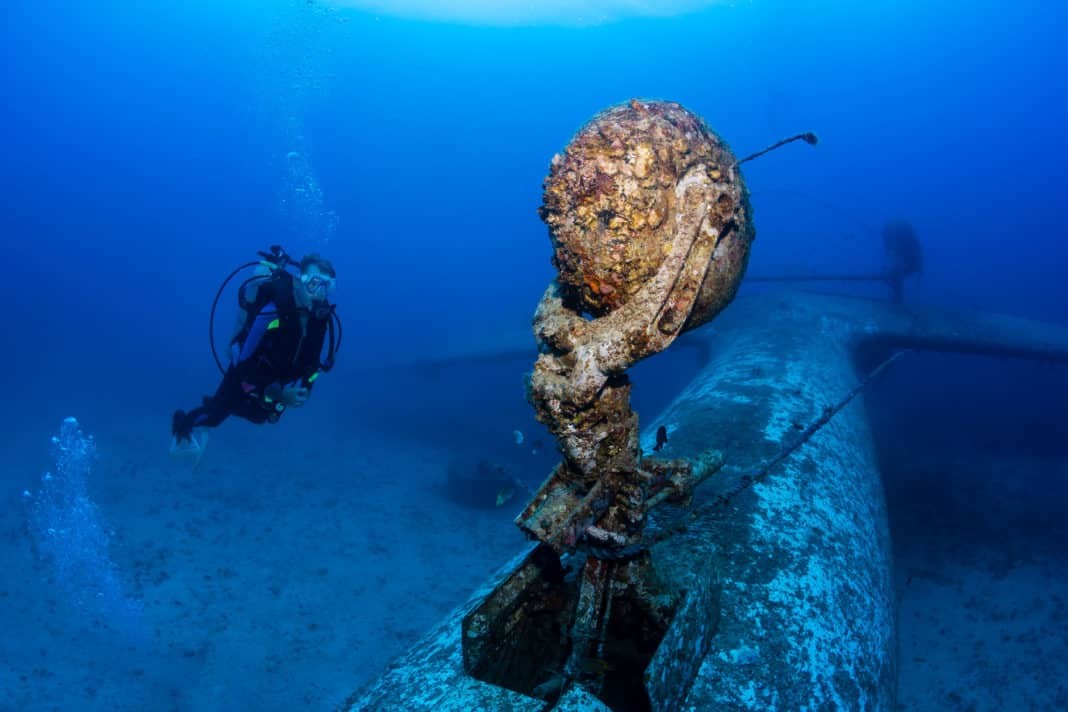There is nothing more magical than submerging beneath the surface of the water, slowly beginning your descent, and from out of the depths seeing the shadow of a shipwreck emerge. A time capsule of life, hidden beneath the waves. A shipwreck is so much more than ‘just’ a wreck though; it is a window into the past, hinting at the life stories of people, their adventures, and their ultimate destruction. In my opinion, there is only one other type of dive that can beat diving a shipwreck… and that is diving on a downed plane. It is surreal to be hovering over a structure in the sea that should be in the air above us. A complete mirror image of what our brains tell us we ought to be seeing. It’s breathtaking. To celebrate my love of aircraft wreck dives, and to hopefully give inspiration to others, here are three of my favorites around the world.
B-29 Bomber, Lake Mead National Recreation Area
The B-29 was a WWII four-engine bomber and is perhaps most well known as the type of aircraft that delivered the Atomic Bomb, ultimately ending the Second World War. Whilst this is not that particular plane in question, you cannot help but be impressed by the sheer size and clear power of this underwater Superfortress. This particular B-29 was on a different mission though: it had officially been assigned to the Upper Atmosphere Research Project. The purpose of this project was to continue testing and developing the Unites States’ intercontinental ballistic missile system. A test was set up at Lake Mead, Nevada. Unfortunately, on the day in question, July 21, 1948, sunlight caused the water to act as a mirror, disorientating the pilot. The plane crashed into the water. Luckily all five crewmen survived, but the plane did not. It sank to the bottom of Lake Mead and now rests at a depth of around 40m. Discovered by divers in 2001/2002 it has since been extensively surveyed by the United States National Parks Service. Limited diving was permitted from 2008-2009 and 2015-2017, and currently, the National Parks Service is assessing the possibility of allowing limited access in 2020.
Mitsubishi G4M1 ‘Betty Bomber’, Chuuk Lagoon, Micronesia
Chuuk (formerly Truk) Lagoon is a sheltered body of water, belonging to the Federated States of Micronesia. During WWII, Chuuk acted as one of the main naval bases for the Japanese Imperial Fleet, until the day of 17th February 1944, when ‘Operation Hailstone’ took place. Using a combined air and ground attack, the U.S. Navy sank over 250 enemy aircraft and more than 50 ships. The Imperial Fleet and their stronghold in Chuuk were destroyed. Today Chuuk is considered a mecca for wreck diving, due to the sheer number of astonishing dives to experience. Perhaps one of the best is the ‘Betty Bomber’ (American bomber planes were often given female nicknames, whilst their fighter planes were named for men). Lying at a depth of approximately 15m, just short of the island of Etan’s runway, it is an easily accessible dive for both recreational and technical divers. Whilst the body of the plane is largely intact, the nose received serious damage. What is particularly attractive about this wreck is how easy it is to explore inside her, not often the case with aircraft wreck dives. However, extreme care should always be taken when diving in an overhead environment. Betty is a perfect shakedown dive in Chuuk before starting on the massive and deeper show-stopping shipwrecks.
B-24 Bomber ‘Tulsamerican’, Croatia
This is a wreck that will always hold a special place in my heart, for many reasons. During WWII the United States only built three long-range heavy-duty bombers in any numbers; the B-29, B-17, and B-24. The B-24 was always considered the ‘ugly duckling’ of the trio, but I am sure anyone lucky enough to dive on this wreck would quickly disagree. The ‘Tulsamerican’, as this B-24 would come to be known, was the very last B-24 to be built by the Douglas Plant of Tulsa, and soon became a community icon. She flew many successful missions during the War, but on December 17th, 1944 when flying a bombing raid over the Adriatic, she was attacked by the German Luftwaffe. She attempted to make it back to the allied airfield on Viz, Croatia, but tragically crashed into the sea, taking some of her crew with her. Today, she rests at a depth of between 37m and 60m. The speed and angle with which she hit the water caused the fuselage to rip in half, the aft section eventually sinking into deeper water at around 60m, and while the Tulsamercian was flipped totally upside down, it is still clearly an airplane and not just a heap of broken metal. In 2017, an expedition to recover any remains of the downed American airmen resulted in the discovery and repatriation of the remains to Arlington of the young pilot, after over 70 years. There are numerous dive centers on Viz that will happily take you out to dive this very special wreck.
This is a tiny taster of all the remarkable aircraft wrecks around the world. Some can be commercially dived and some are considered too archaeologically important to be dived recreationally, but diving any aircraft wreck is a unique and exhilarating experience. So get out there and explore!

